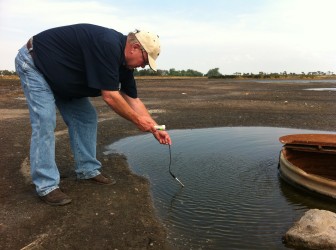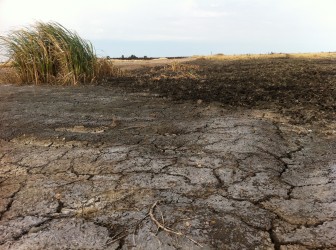North Dakota is in the middle of a historic oil boom, producing over one million barrels of oil each day. But it’s producing a whole lot more of something else, something that’s not valuable at all: saltwater, a waste product of drilling. The state has strict requirements for getting rid of the waste water. But as more and more wells are drilled, saltwater spills have increased dramatically.
According to an Inside Energy analysis of state data, in the past year there were 810 saltwater spills in North Dakota. That comes out to about five gallons of saltwater spilled per minute. And the overall spill rate — the number of both oil and saltwater spills per well – has also gone up, nearly tripling in the past decade.
Map: A Year of Saltwater Spills
This map shows the number of saltwater spills reported in North Dakota, by county, in the past year. Darker colors correspond to more spills. The grey dots are active oil and gas wells. Mouse over a county to see how many saltwater spills it had, how many barrels of saltwater were released, and how many active oil and gas wells are in that county.
There’s a clear relationship between the number of active wells and the number of spills. McKenzie County, in the heart of the Bakken shale formation, has a state-high 2,429 active wells, and also had the most saltwater spills: 201 spills released 37,478 barrels of saltwater in the past year.
Saltwater is 10 to 30 times saltier than ocean water. It comes up from deep underground aquifers along with the oil, and may contain fracking chemicals, heavy metals and radioactive material. And even though North Dakota requires oil companies to pump saltwater back underground, there are many ways it can leak.

Emily Guerin
Daryl Peterson tests the water at the site of a saltwater spill with his electro conductivity meter, which will tell him how much salt is in the water.
Kris Roberts has seen them all. He’s an inspector for the North Dakota Department of Health, and his job is to drive around the state and look at spills.
“We have pipeline leaks, lightning strikes, leaks at oil well sites, we have illegal discharges by truckers who do not want to wait at saltwater disposal wells,” he says. “If there’s a way it can happen, it probably will.”
Part of the increase is because drilling activity is increasing, says Bruce Hicks, assistant director of the state’s Department of Mineral Resources. The important thing, he said, is that over 80 percent of all spills stay on the well pad and don’t contaminate ground or surface water.
But it’s not just the number of spills that are up–the spill rate is also higher now than it was 10 years ago. According to data provided by the Department of Mineral Resources, in 2004, before the boom, there was one spill for every 16 wells. Back then, there were just under 4000 wells. By 2013, there were over 11,000 wells in North Dakota and the spill rate was one per every six wells.
Lynn Helms is the director of the Department of Mineral Resources–Hicks’ boss. He said the spike in the spill rate may be related to North Dakota’s short construction season and hundreds of miles of new saltwater pipelines going in.
“That’s about the best explanation I can come up with at this point,” he said, “is that the majority are being caused by valve and piping connections. And that’s a construction practice.”
Others – both in and outside the industry – speculate it has to do with a frenzy of new well construction, and companies cutting corners as they lay pipeline.

Emily Guerin
A saltwater spill on land near Daryl Peterson’s farm outside Antler, North Dakota.
The state is trying to address the problem. New regulations that took effect April 1 require pipeline companies to map their routes and report what the pipelines are carrying. And the Department of Mineral Resources already employs more oilfield inspectors per well than many other Western states–including Wyoming and Colorado — and they’re hiring more. Helms says his department is toying with the idea of threatening to prevent companies from transporting oil or gas from a well site if they don’t comply with regulations — something Texas already does and finds to be very effective.
But farmers like Daryl Peterson, whose soybeans have been damaged by past saltwater spills, complain enforcement is too weak. North Dakota can fine companies up to $12,500 per day for a spill, but if a company cooperates with the clean up process they’ll rarely see a monetary penalty. Plus, fines are often reduced.
Given the plan to drill tens of thousands more oil wells in North Dakota, Peterson is realistic about what to expect. “I think the goal should be no spills,” he said. And then, “that’s probably impossible.”
Still, he wants landowners living amid North Dakota’s newest oil boom — the Bakken — to use him and his neighbors, who live amid older, less well-maintained oil infrastructure, as a cautionary tale.
“If this type of behavior doesn’t change,” he said, as we drove past rusty storage tanks and old pumpjacks, “it’s coming the Bakken way. When those wells get old and aren’t as productive, this same mentality will be there.”
Related: Saltwater Spills in North Dakota: Data Woes And Wins









